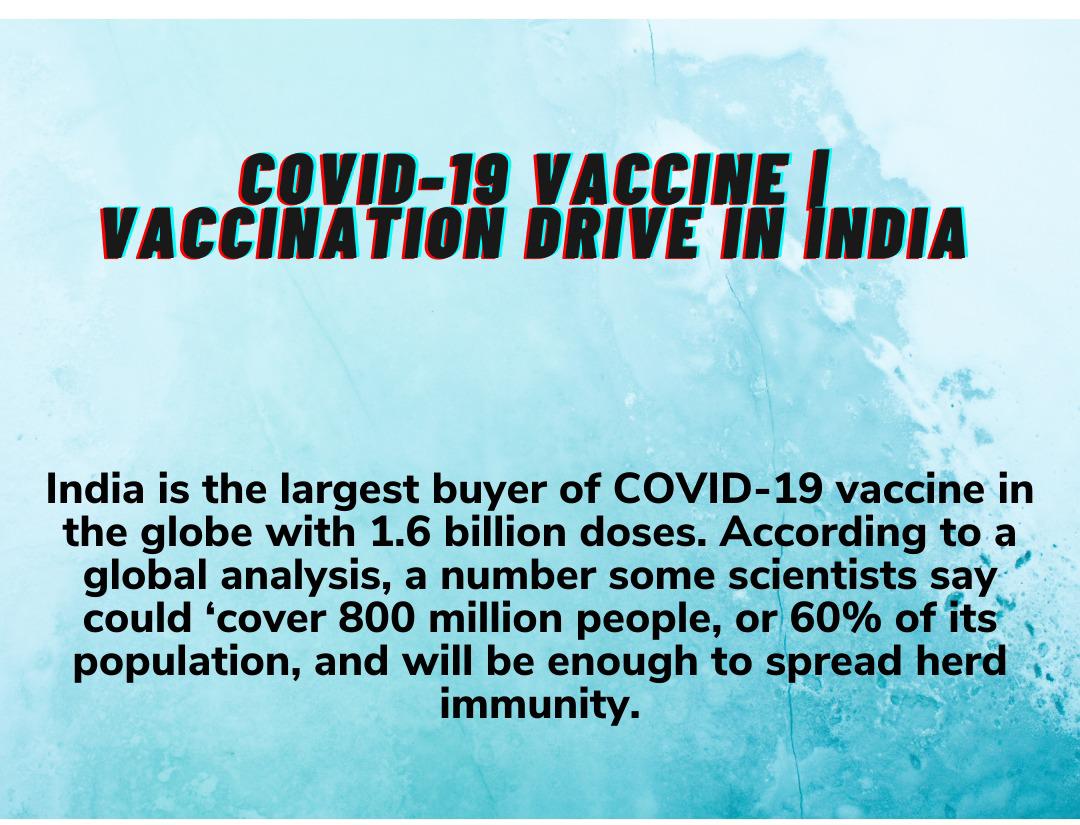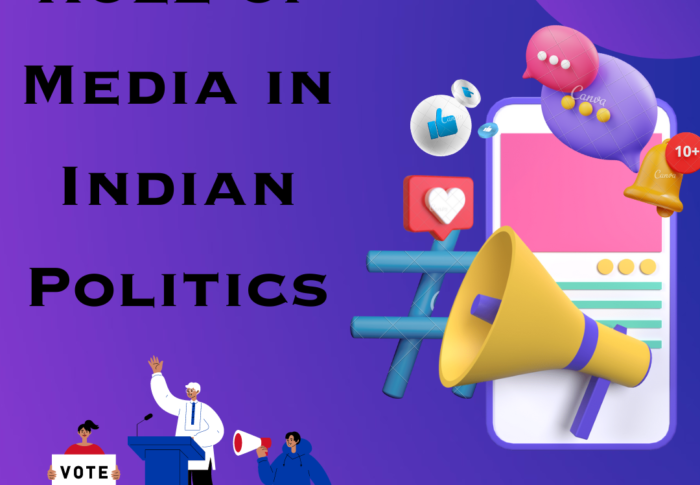
COVID-19 Vaccine | Vaccination Drive in India
India is the largest buyer of COVID-19 vaccine in the globe with 1.6 billion doses. According to a global analysis, a number some scientists say could ‘cover 800 million people, or 60% of its population, and will be enough to spread herd immunity.
AUTHOR : SHIKHA MISHRA
Introduction
The outburst of the COVID-19 epidemic has resulted in the universal loss of lives and livelihood across the world. The numbers are multiplying daily on a vast scale. The government, all over the globe has declared lockdown over the whole of the countries, to minimize the destructive effects. But, it is just a precautionary temporary course of action, not an enduring solution. In India, On 24 March, the government declared a nationwide lockdown, which was expanded further resulting in lockdown 2.0. The lockdown has resulted in putting up the shutters of businesses whether small or large, completely for quite a long time, putting the economy at vital risk. Without-doubt the economies all over the globe either are in the recession stage or are going to end up in a recession.
Its Impact on Indian Economy
Akin to humans breathing in and out; economies pattern between recession and growth. A Recession is a slowdown or a massive decline in economic activities. A notable fall in spending generally leads the way to a recession. Such a downturn in economic activities may last for some quarters thus completely hindering the rise of an economy. In such circumstances, economic indicators like GDP, employment, corporate profits, etc. reduce. This makes a mess in the whole economy. There is a drop in manufacturing and industrial production and a downturn in consumer spending. The Covid-19 epidemic is different because this quandary is a public health urgency leading to sickness and death. The lockdowns requisite to contain the virus are in turn lessening economic activities and aggravating human suffering. It is likely to become the stipulating event and cause important disruptions for businesses and customers. The financial and economic inference could be riskier than ever imagined.
Acceptability by the people
For India, dislocations begun by Covid-19 can be by several channels, of which the dislocation of supply chains is the important one. Unemployment upmost the charts as a result of the downturn in manufacturing and service activities. Workers are back to their hometowns miles away from places, therefore leaving the upcoming events of businesses in unpredictability. Lack of orders may at last lead the way to enormous trade contraction. Further, there is a drop in the value of the Indian rupee, thus hindering exports and imports. There is a disturbance in air travel and tourism too. In addition to more to the list, is the contraction in entertainment industries, increase in bankruptcy, and NPAs. Most economists expect a double-digit lessen in world GDP for the second quarter of 2020.
The World Bank and rating agencies had initially downgraded India’s growth for the fiscal year 2021 with the lowest figures India has seen in three decades since India’s economic liberalization in the 1990s. Although, after the declaration of the economic raft in the middle of, India’s GDP estimates were downgraded ever more to negative figures, signaling a deep recession. Within a month, unemployment rose from 6.7% on 15 March to 26% on 19 April, according to various sources. During the course of the lockdown, an approximated 14 crore individuals lost employment. More than 45% of households across the nation have reported an income drop as compared to the previous year.
The world is foregrounding humanity’s biggest setback being World War II. The report touches on that even before the coronavirus outburst, the world economy, in the outcome of the world financial setbacks, was facing the triple challenge of debt, demographics, and disinflation or 3D challenge. which the world last faced in the 1930s. The debt challenge will become more evident in the near term as nominal GDP development weakens and nations, households, and companies face rising levels of indebtedness.
The spread of the COVID-19 has sent financial markets into a twist besides some of the biggest emergency stimulus measures since the global financial crisis declared by dozens of central banks throughout Europe, the Americas, Australia and Asia. The fright was clear in stocks, bonds, gold and commodity prices, underlining expectations of critical economic damage from the outburst. This crisis is not simply a more serious version of the usual business cycle recession, the typical contraction in which economies ultimately adjust and steady.
Applicability of the Vaccination Programme
India is the largest buyer of COVID-19 vaccine in the globe with 1.6 billion doses. According to a global analysis, a number some scientists say could ‘cover 800 million people, or 60% of its population, and will be enough to spread herd immunity.
India has bought 500 million doses of the Oxford University-AstraZeneca vaccine volunteer, 1 billion from the US company Novavax and 100 million doses of the Sputnik V volunteer from Russia’s Gamaleya Research Institute, As per the US-based Duke University Global Health Innovation Center.
As stated in the analysis, India is the top COVID-19 vaccine purchaser followed by the European Union which has confirmed 1.58 billion doses, and the US, the worst affected country as yet, that has managed to buy just over a billion doses.
As countries planned to secure more shots to prevent their populations against the novel coronavirus disease, Duke University has declared a new global valuation of purchasing agreements for COVID-19 vaccine, even before any aspirant is in the market.
“Countries with manufacturing dimension, that is India and Brazil, have been successful in negotiating huge advance market commitments with leading vaccine volunteers as part of the manufacturing agreements,” the Duke researchers noted in their assessment.
The ILO report has assessed the effect of the epidemic on the global labour market. It finds that 8.8% of world working hours were lost the previous year, resulting in a decrease in global labour income equivalent to US$ 3.7 trillion. With the estimation of recovery in the second half of 2021, depending on vaccination launch, it has also put up international support for low- and middle-income countries to support vaccine launch, and to foster economic and employment recovery.
The few sectors are the ones that are now carrying most of the Covid-19 epidemic burden and have yet to start work anywhere near the pre-Covid-19 period. They are also the sectors responsible for extensive job losses and consumption lessens,” said Amir Ullah Khan, Senior Researcher of Rajiv Gandhi institute for Contemporary Studies, a social workshop.
India’s stage one of COVID vaccination is ongoing and while there are some question marks on it, the bigger question as of now is whether it will boost the next stage of economic recovery. Specialists think that the services sector will get a major push with some calling it the biggest economic boost in this upcoming budget
It remains depressed because of fright and the only way to revive the services sector is to vaccinate a large number of individuals in a short span of time. Vaccination must be free for all and organization players should be reimbursed,” stated by Swaminathan Aiyar, Consulting Editor, Economic Times Now.
FOR MORE INFORMATION VISIT OUR SITE






